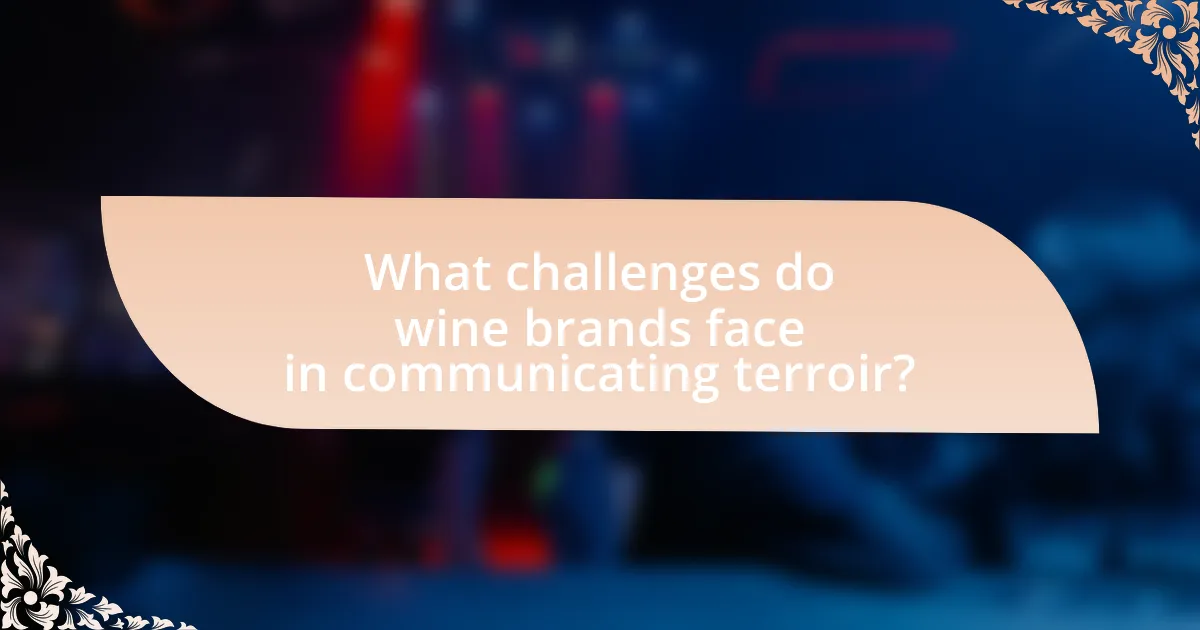The article examines the critical role of terroir in wine branding, highlighting how geographic factors such as soil composition, climate, and topography influence the unique characteristics and quality of wines. It discusses how terroir affects consumer perception, brand identity, and pricing, emphasizing the importance of authenticity and regional origin in consumer choices. Additionally, the article explores marketing strategies that effectively communicate terroir, the challenges brands face in conveying its complexity, and the emerging trends in consumer preferences for terroir-driven wines. The significance of sustainability and collaborations with local producers in enhancing terroir branding is also addressed.

What is the Role of Terroir in Wine Branding?
Terroir plays a crucial role in wine branding by influencing the unique characteristics of wine that are tied to specific geographic locations. This concept encompasses factors such as soil composition, climate, and topography, which collectively shape the flavor profile and quality of the wine produced in that area. For instance, wines from Bordeaux are often associated with specific grape varieties and distinct taste profiles due to the region’s unique terroir, enhancing their marketability and brand identity. The recognition of terroir allows wineries to differentiate their products, establish authenticity, and command premium pricing, as consumers increasingly seek wines that reflect their origin.
How does terroir influence the perception of wine brands?
Terroir significantly influences the perception of wine brands by shaping the unique characteristics of the wine, which consumers associate with quality and authenticity. Terroir encompasses the environmental factors, including soil composition, climate, and topography, that affect grape cultivation. For instance, wines from the Bordeaux region are often perceived as premium due to the area’s specific terroir, which contributes to the complexity and richness of the wines produced there. Studies have shown that consumers are willing to pay higher prices for wines that are linked to prestigious terroirs, reinforcing the brand’s image and market value. This connection between terroir and brand perception is evident in the marketing strategies of wine producers, who often highlight their unique terroir to differentiate their products in a competitive market.
What elements constitute terroir in the context of wine?
Terroir in the context of wine is constituted by a combination of environmental factors, including soil composition, climate, topography, and human influence. Soil composition affects the nutrients available to the vines, while climate determines the temperature and rainfall patterns that influence grape ripening. Topography, including elevation and slope, impacts sunlight exposure and drainage. Human influence encompasses vineyard management practices and winemaking techniques. These elements collectively shape the unique characteristics of a wine, contributing to its flavor profile and quality, as evidenced by studies showing that wines from different terroirs exhibit distinct sensory attributes.
How do climate and geography shape the characteristics of wine?
Climate and geography significantly influence the characteristics of wine by affecting grape growth, flavor profiles, and overall quality. The climate determines temperature, rainfall, and sunlight, which are crucial for the ripening of grapes; for instance, warmer climates typically produce riper, fruitier wines, while cooler climates yield wines with higher acidity and more delicate flavors. Geography, including soil type, elevation, and proximity to bodies of water, further impacts grape characteristics; for example, volcanic soils can impart unique mineral qualities to the wine, while elevation can enhance acidity and freshness. Studies have shown that regions like Bordeaux and Napa Valley produce distinct wine styles due to their specific climatic and geographical conditions, reinforcing the concept of terroir in wine branding.
Why is terroir important for wine producers?
Terroir is important for wine producers because it encompasses the unique environmental factors that influence the characteristics of wine, including soil, climate, and topography. These elements contribute to the distinct flavor profiles and quality of the wine, allowing producers to create products that reflect their specific geographic origins. For instance, studies have shown that wines from regions like Bordeaux or Burgundy possess unique attributes tied to their terroir, which can enhance their market value and brand identity. This connection to place not only differentiates wines in a competitive market but also appeals to consumers seeking authenticity and a sense of origin in their purchases.
How does terroir contribute to the uniqueness of a wine brand?
Terroir contributes to the uniqueness of a wine brand by encompassing the specific environmental factors, including soil composition, climate, and topography, that influence grape cultivation. These elements create distinct flavor profiles and characteristics in the wine, which are often tied to the geographic origin of the grapes. For example, wines from the Bordeaux region exhibit unique tannin structures and fruit flavors due to the area’s clay and limestone soils, as well as its temperate maritime climate. This distinctiveness not only enhances the wine’s quality but also strengthens brand identity, as consumers often associate specific terroirs with particular taste experiences, thereby fostering brand loyalty.
What role does terroir play in establishing brand identity?
Terroir plays a crucial role in establishing brand identity by linking a wine’s characteristics to its geographical origin, which influences consumer perception and preference. The unique combination of soil, climate, and topography in a specific region imparts distinct flavors and qualities to the wine, making it recognizable and desirable. For instance, wines from Bordeaux are often associated with richness and complexity due to the region’s specific terroir, which enhances brand loyalty and differentiation in a competitive market. This connection between terroir and brand identity is supported by studies showing that consumers often prefer wines that reflect their regional origins, reinforcing the importance of terroir in branding strategies.

How do consumers perceive terroir in wine branding?
Consumers perceive terroir in wine branding as a critical factor that influences their purchasing decisions and overall appreciation of wine. Terroir, which encompasses the unique environmental conditions, soil types, and climate of a vineyard, is often associated with quality and authenticity in wine. Research indicates that consumers are willing to pay a premium for wines that are marketed with a strong terroir narrative, as it enhances their perception of the wine’s uniqueness and origin. For instance, a study published in the Journal of Wine Economics found that wines labeled with specific geographic indications command higher prices, reflecting consumer trust in the terroir’s influence on quality. This perception is further reinforced by the growing trend of consumers seeking authentic and local products, making terroir a vital component in wine branding strategies.
What factors influence consumer understanding of terroir?
Consumer understanding of terroir is influenced by several key factors, including education, marketing, sensory experience, and cultural context. Education plays a crucial role, as consumers who are informed about the geographical, climatic, and soil conditions that contribute to terroir are better equipped to appreciate its significance in wine. Marketing strategies employed by wineries also shape consumer perceptions; effective storytelling and branding can enhance the perceived value of terroir. Sensory experience, such as tasting and aroma, allows consumers to connect with the unique characteristics of wines from specific regions, reinforcing their understanding of terroir. Additionally, cultural context, including regional traditions and historical practices, further influences how consumers interpret and value terroir in wine.
How does education about terroir affect consumer choices?
Education about terroir significantly influences consumer choices by enhancing their understanding of the unique characteristics of wines linked to specific geographic regions. When consumers are educated about how factors like soil composition, climate, and traditional practices affect the flavor and quality of wine, they are more likely to appreciate and seek out wines that reflect these attributes. Research indicates that consumers who are knowledgeable about terroir are willing to pay a premium for wines that they perceive as having a distinct sense of place, as evidenced by a study published in the Journal of Wine Economics, which found that informed consumers often prioritize terroir in their purchasing decisions. This connection between education and consumer behavior underscores the importance of terroir in wine branding, as it fosters a deeper appreciation and loyalty towards specific wine producers and regions.
What marketing strategies highlight terroir in wine branding?
Marketing strategies that highlight terroir in wine branding include storytelling, geographical labeling, and sensory marketing. Storytelling emphasizes the unique characteristics of the vineyard’s location, climate, and soil, creating an emotional connection with consumers. Geographical labeling, such as using specific appellations or designations, reinforces the wine’s origin and authenticity, which is crucial for premium positioning. Sensory marketing engages consumers through tastings and experiences that showcase the wine’s distinct flavors and aromas, directly linked to its terroir. These strategies are effective as they leverage the growing consumer interest in authenticity and provenance in the wine market.
Why do some consumers prioritize terroir in their wine selections?
Some consumers prioritize terroir in their wine selections because they believe it significantly influences the wine’s flavor, aroma, and overall quality. Terroir encompasses the unique environmental factors, such as soil composition, climate, and topography, that affect grape cultivation. Research indicates that wines from specific regions exhibit distinct characteristics attributed to these factors, leading consumers to associate terroir with authenticity and a sense of place. For instance, studies have shown that wines from Bordeaux are often perceived as more complex due to the region’s unique terroir, reinforcing consumer preference for wines that reflect their geographical origins.
How does the perception of terroir impact pricing and value?
The perception of terroir significantly impacts pricing and value in the wine industry by influencing consumer preferences and perceived quality. Terroir encompasses the unique environmental factors, such as soil, climate, and topography, that contribute to the characteristics of a wine. Wines from regions with a strong terroir reputation, like Bordeaux or Burgundy, often command higher prices due to their perceived exclusivity and quality. For instance, a study by the University of California, Davis, found that wines labeled with specific terroir attributes can sell for up to 30% more than those without such designations, demonstrating that consumer willingness to pay is closely tied to the perceived authenticity and uniqueness of the terroir.
What trends are emerging in consumer preferences regarding terroir?
Emerging trends in consumer preferences regarding terroir indicate a growing appreciation for authenticity and local identity in wine. Consumers increasingly seek wines that reflect their specific geographic origins, valuing unique characteristics tied to soil, climate, and traditional practices. This shift is supported by data from the 2022 Wine Market Council report, which shows that 62% of wine drinkers prioritize terroir-driven wines, highlighting a significant increase in demand for products that tell a story of place. Additionally, younger consumers, particularly Millennials and Gen Z, are more inclined to explore wines from lesser-known regions, further emphasizing the importance of terroir in their purchasing decisions.

What challenges do wine brands face in communicating terroir?
Wine brands face significant challenges in communicating terroir due to the complexity of the concept and consumer understanding. Terroir encompasses various factors such as soil composition, climate, and local traditions, which can be difficult to convey succinctly. Additionally, consumers often lack familiarity with these elements, leading to misconceptions about what terroir truly represents. Research indicates that 70% of wine consumers prioritize taste over geographical origin, highlighting a disconnect between the importance of terroir and consumer perception. Furthermore, the diverse interpretations of terroir across different wine regions can create confusion, as brands may struggle to differentiate their unique characteristics in a crowded market.
How can wine brands effectively convey the concept of terroir?
Wine brands can effectively convey the concept of terroir by emphasizing the unique environmental factors that influence their wines, such as soil composition, climate, and topography. By providing detailed information about the specific vineyard locations, including geological characteristics and microclimates, brands can create a narrative that connects consumers to the land where the grapes are grown. For instance, brands like Château Margaux highlight their distinct terroir through storytelling and educational content, showcasing how these elements contribute to the wine’s flavor profile. This approach not only enhances consumer understanding but also fosters a deeper emotional connection to the product, reinforcing the authenticity and quality associated with the concept of terroir.
What are common misconceptions about terroir among consumers?
Common misconceptions about terroir among consumers include the belief that terroir solely refers to the geographical location of vineyards, neglecting the influence of climate, soil composition, and winemaking practices. Many consumers also mistakenly think that terroir guarantees a specific taste or quality in wine, while in reality, it contributes to a complex interplay of flavors that can vary significantly from year to year. Additionally, some consumers assume that all wines from a particular region will taste the same, overlooking the diversity of styles and techniques employed by different producers within that area. These misconceptions can lead to a limited understanding of how terroir shapes wine characteristics and branding.
How can storytelling enhance the understanding of terroir?
Storytelling enhances the understanding of terroir by providing a narrative that connects the unique characteristics of a specific region to the wine produced there. This narrative allows consumers to grasp the influence of climate, soil, and local traditions on the flavor profile and quality of the wine. For instance, a vineyard’s history, the winemaker’s philosophy, and the specific environmental conditions can be woven into a compelling story that illustrates how these elements shape the wine’s identity. Research indicates that consumers are more likely to appreciate and value products when they understand the story behind them, as evidenced by studies showing that storytelling can increase perceived quality and willingness to pay for wine.
What best practices can wine brands adopt to leverage terroir?
Wine brands can leverage terroir by emphasizing the unique characteristics of their growing regions in marketing and storytelling. This involves highlighting specific soil types, climate conditions, and local traditions that contribute to the wine’s distinct flavor profile. For instance, brands can use detailed descriptions of their vineyard’s microclimate and geological features to create a narrative that connects consumers to the origin of the wine. Research shows that consumers are willing to pay a premium for wines that convey a strong sense of place, as evidenced by a study published in the Journal of Wine Economics, which found that wines with clear terroir branding can command higher prices. By effectively communicating these elements, wine brands can enhance their identity and appeal to consumers seeking authenticity and quality.
How can collaborations with local producers enhance terroir branding?
Collaborations with local producers enhance terroir branding by creating authentic connections between the product and its geographical origin. These partnerships allow for the sharing of traditional practices and local knowledge, which can improve the quality and uniqueness of the wine. For instance, a study by the University of California, Davis, highlights that wines produced in collaboration with local growers often reflect the specific characteristics of the terroir, such as soil composition and climate, leading to a stronger brand identity. This authenticity resonates with consumers, who increasingly seek products that tell a story and reflect their origins, thereby increasing market value and consumer loyalty.
What role does sustainability play in terroir-focused branding?
Sustainability is integral to terroir-focused branding as it enhances the authenticity and quality perception of wine. By emphasizing sustainable practices, wineries can demonstrate a commitment to environmental stewardship, which resonates with consumers increasingly concerned about ecological impacts. For instance, studies show that 66% of consumers are willing to pay more for sustainable products, indicating that sustainability can significantly influence purchasing decisions in the wine market. Additionally, sustainable viticulture practices, such as organic farming and biodiversity conservation, directly contribute to the unique characteristics of terroir, reinforcing the brand’s narrative and connection to the land.
What practical tips can wine brands use to highlight terroir effectively?
Wine brands can effectively highlight terroir by emphasizing the unique characteristics of their vineyard locations through storytelling, labeling, and sensory experiences. Storytelling can include detailed descriptions of the soil composition, climate, and historical context of the vineyard, which helps consumers connect emotionally with the product. For labeling, brands should include specific terms related to terroir, such as the region, sub-region, and even specific vineyard names, which can enhance authenticity and credibility. Sensory experiences, such as tastings that focus on the distinct flavors and aromas derived from the terroir, allow consumers to engage directly with the product’s origin. Research indicates that consumers are increasingly interested in the provenance of their wine, with a survey by Wine Intelligence showing that 70% of wine drinkers consider terroir important when making purchasing decisions.